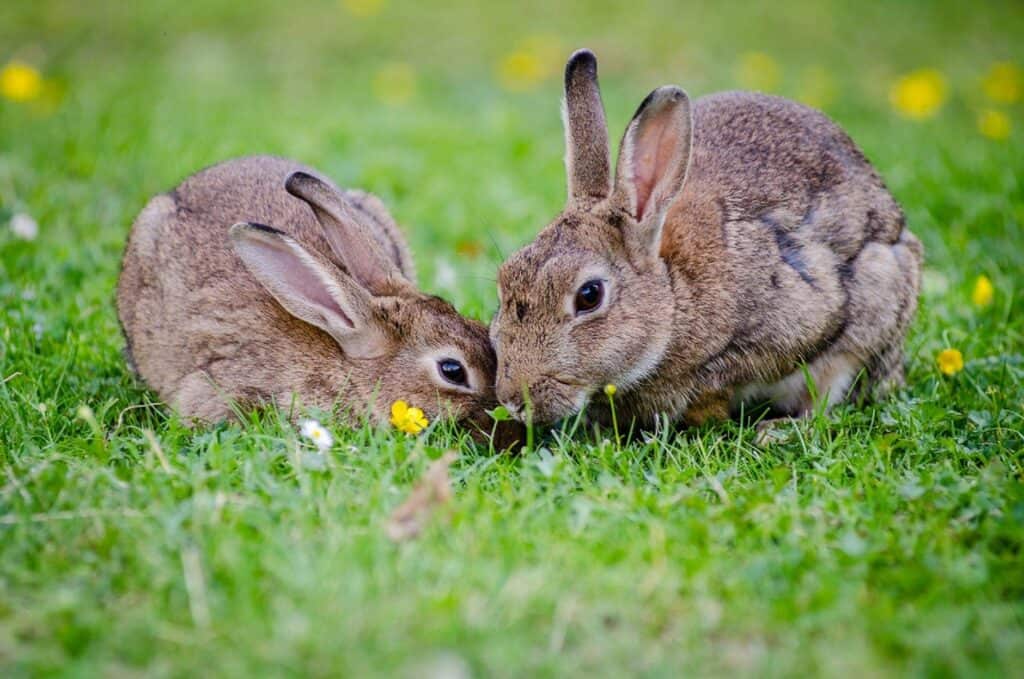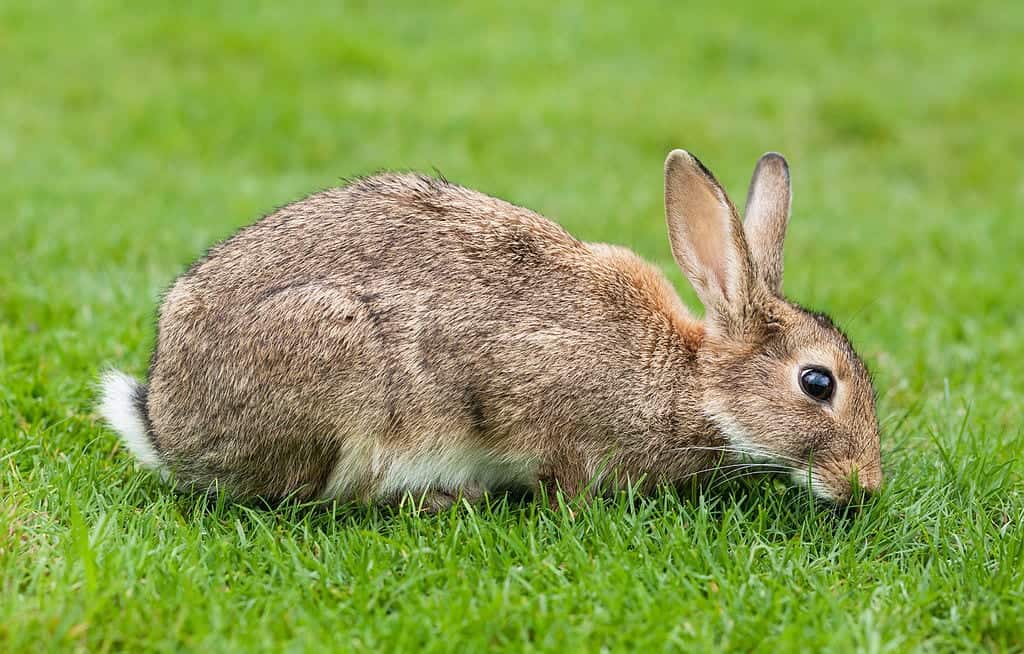The European rabbit (Oryctolagus cuniculus) is a wild rabbit native to Spain, France, and Portugal. In Australia, these wild rabbits are considered pests due to their impact on crops, but the domesticated form of the European rabbit, simply called “domestic rabbit” or “domesticated rabbit” is kept as a much-loved family companion in many households around the world. In this post, we’ll walk you through how to care for your domestic rabbit.
| Size: | Up to 16 inches in length (wild), miniature/dwarf, medium, giant (domestic breeds) |
| Weight: | Up to around 15 pounds depending on size (dwarf/miniature, medium, etc.) |
| Lifespan: | 5–12 years |
| Similar Breeds: | All domestic rabbit breeds (approximately 305 breeds) |
| Suitable for: | Gentle and caring families that will treat the rabbit with love and respect |
| Temperament: | Varies, some are shy, skittish, and/or independent, whereas others are confident, docile, and friendly |
European rabbits are the ancestors of domestic rabbits, of which there is a multitude of breeds, including the Rex, Angora, Netherland Dwarf, Lionhead, and the Belgian Hare, which was developed to share similar physical characteristics to the European Hare (distinct from the European rabbit). Due to this diversity, domestic rabbits come in a wide variety of shapes, sizes, colors, and coat types.

European Rabbit Breed Characteristics
Note: Please note that, since there are so many domestic rabbit breeds, these characteristics may vary by breed.
[yasr_multiset setid=7]
Temperament & Intelligence of the European Rabbit
Rabbits are very intelligent animals that can be housetrained and taught to do things like jump up onto furniture, sit up, and follow a target. Some even learn more advanced tricks, like circling around to follow a target, and do well in agility training. Like other animals, rabbits have individual personalities and quirks.
While some are extraverted and love cuddling and grooming their favorite people, others have a more independent streak or take a while to warm up to people.
Can European Rabbits be Kept as Pets?
It’s not a good idea to head out and capture a wild European rabbit to live with you as a pet, but domestic rabbits can make lovely pets if they’re gently and sensibly handled and properly cared for. Rabbits are often considered good pets for kids, and they absolutely can be, but it’s important to remember that rabbits can be very shy, sensitive, and have fragile backs.
For these reasons, if children handle the rabbit, they should do so under supervision and be taught how to properly hold them. Rabbits should only be handled by adults and older children who can understand the importance of gentle handling, especially since a nervous rabbit is likely to jump out of your arms and possibly acquire an injury from doing so.
Does This Rabbit Get Along with Other Animals?
It’s a good idea to keep rabbits in pairs because they need to be social and thrive off of companionship. According to the RSPCA, paired rabbits are typically happier and calmer than rabbits kept alone, which can contribute to the rabbits living longer and healthier lives.
As for whether domestic rabbits get along with other animals like cats and dogs, this depends on the animals’ personalities. Letting a rabbit interact with a dog that has a strong prey drive or chase instinct, for example, wouldn’t be recommended. On the other hand, a calm and unflustered dog or cat may get along perfectly well with your rabbit.
Things to Know About European Rabbits
Food & Diet Requirements
Whichever domestic rabbit breed you have, the most important part of a rabbit’s diet is good-quality hay because it’s crucial for their digestive health and dental health—a rabbit’s teeth are always growing, and hay can help keep this in check. Your rabbit should be fed a hay bundle on a daily basis, and this bundle should be about the same size as the rabbit.
Rabbits up to 7–8 months old should have free-choice alfalfa pellets and alfalfa hay to support their growth and development, but adult rabbits shouldn’t eat alfalfa hay.
In addition to hay, rabbits can have a certain amount of pellets in proper portions (check the packet or ask your vet to find out how much would be appropriate) and supplementary leafy green vegetables. Safe vegetables that rabbits can eat (after washing, of course) include romaine lettuce, broccoli greens, watercress, and Bok choy. Your rabbit should also have access to clean water.

Habitat
Your rabbit will need a secure hutch that is, at a minimum, four times their size. If you have more than one rabbit, this will need to be doubled. Check that the hutch is in an area that isn’t too hot, cold, damp, drafty, or in direct sunlight and that your rabbit or rabbits have enough room to stand up fully, turn around, play with toys, use the bathroom, hide, eat, and drink comfortably.
Wire-sided enclosures are more convenient, as wood is much harder to properly clean. Ideally, the hutch should be indoors but, if this isn’t possible, an alternative option to look into is an outdoor shed. This provides better protection from the elements and potential predators than simply putting the hutch out in the open in your yard.
Hay (dust-free) and shredded paper are good bedding choices for rabbits. The hutch should be thoroughly cleaned at least once weekly, and daily spot cleaning should be performed to freshen it up as necessary.
Exercise & Sleeping Needs
If you’re considering making a rabbit your new family companion, it’s important to bear in mind that these animals require a dedicated exercise spot in addition to their hutch, and they should be able to roam freely within this area for at least 4 hours per day, but more if possible.
The rabbit should be able to easily reach their hutch from the exercise area so they can retreat to somewhere they feel safe any time they need to while out roaming. Some people use playpens to create an exercise area, whereas others use baby gates. In terms of sleep, rabbits are crepuscular, so their activity levels are highest at dawn, dusk, and during the night.

Lifespan and Health Conditions
Rabbits can live for up to 12 years and, sometimes, even longer if their owner has done an excellent job caring for them. As a rabbit parent, it’s important to be aware of the potential health issues that could affect your bunny so you can school yourself on what to look out for. Here are some common rabbit ailments:
- Dry or itchy skin
- Myxomatosis
- Dental disease
- Upper respiratory infections
- Parasites
- Uterine conditions
- Gastrointestinal stasis
- Pododermatitis

Male vs Female
Both male and female rabbits can make great companions and their personalities are their own—it doesn’t matter what gender they are. There are some generalizations floating about, though. Some say that male rabbits are generally more extroverted and people-oriented than females, but that doesn’t mean females can’t be just as sweet. It’s all down to the individual rabbit.
Both genders can be handfuls during puberty, though. Unneutered and unspayed rabbits often display more aggression and territorial behavior, so you might want to think about consulting your vet about having your rabbit desexed.

3 Little-Known Facts About European Rabbit
1. European Rabbits Were First Introduced to Australia in the 1800s
This fact has proven to be a thorn in Australia’s side since its wild European rabbit population (which is very difficult to manage) threatens crops and ecosystems. For this reason, they’re considered to be an invasive species on the continent.
2. European Rabbits Are Highly Adaptable
It’s easy for wild European rabbits to come across their ideal habitat—an area to burrow in and in which grass grows. This is how the wild rabbit population in Australia has become such a problem—these rabbits are simply easy to please.
3. Rabbits Have an Excellent Field of Vision
The position of the rabbit’s eyes allows them to see almost 360 degrees. This helps them to survive in the wild and even allows them to spot predators flying very high above them.

Final Thoughts
The domestic version of the European rabbit is incredibly diverse and accounts for more than 300 pet rabbit breeds. This means you’ll always be spoiled for choice when it comes to picking the perfect fluffy companion.
Take note, however, that in spite of rabbits’ reputation for being easy to care for, this isn’t really the case—these are sensitive animals with an array of care requirements that need extra careful handling.
Interested in learning about more rabbit breeds? Check out:
- Giant Chinchilla Rabbit Breed Info: Pictures, Traits, & Facts
- Giant Papillon Rabbit Breed Info: Pictures, Traits, & Facts
- American Rabbit Breed Info: Pictures, Traits, Facts
Featured Image Credit: Pepemendez00, Shutterstock
